30 years ago today, a supernova explosion was spotted in the southern hemisphere skies. The exploding star was located in the Large Magellanic Cloud — a satellite galaxy of the Milky Way – and Supernova 1987A was the brightest and nearest supernova explosion for modern astronomers to observe. This has provided an amazing opportunity to study the death of a star.
Telescopes around the world and in space have been keeping an eye on this event, and the latest images show the blast wave from the original explosion is still expanding, and it has plowed into a ring expelled by the pre-supernova star. The latest images and data reveal the blast is now moving past the ring.
Got a 3-D printer? You can print out your own version of SN1987A! Find the plans here.
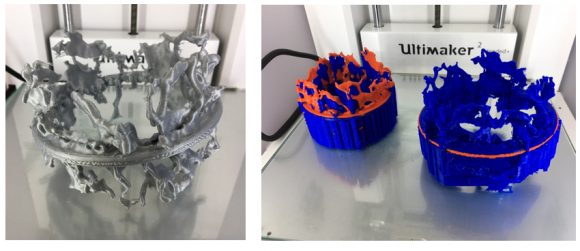
Below is the latest image of this supernova, as seen by the Hubble Space Telescope. You can see it in the center of the image among a backdrop of stars, and the supernova is surrounded by gas clouds.
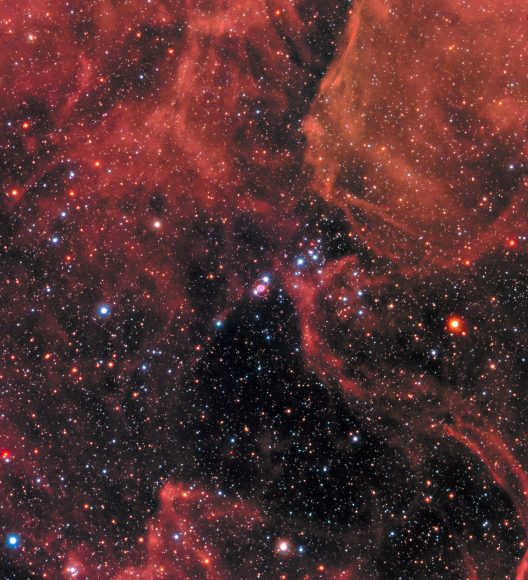
Hubble launched in 1990, just three years after the supernova was detected, so Hubble has a long history of observations. In addition, the Chandra X-ray telescope – launched in 1999 – has been keeping an eye on the explosion too.
Here are a few animations and images of SN1987A over the years:
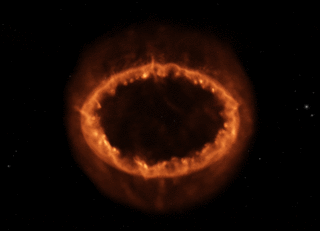
Credits: NASA, ESA, and F. Summers and G. Bacon (STScI); Simulation Credit: S. Orlando (INAF-Osservatorio Astronomico di Palermo)
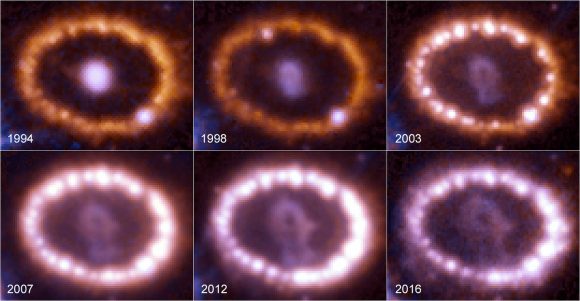
NASA, ESA, and R. Kirshner (Harvard-Smithsonian Center for Astrophysics and Gordon and Betty Moore Foundation) and P. Challis (Harvard-Smithsonian Center for Astrophysics)
Here’s a link to the original astronomer’s telegram announcing the detection.
Astronomers estimate that the ring material was was ejected about 20,000 years before the actual explosion took place. Then, the initial blast of light from the supernova illuminated the rings. They slowly faded over the first decade after the explosion, until the shock wave of the supernova slammed into the inner ring in 2001, heating the gas to searing temperatures and generating strong X-ray emission.
The observations by Hubble, Chandra and telescopes around the world has shed light on how supernovae can affect the dynamics and chemistry of their surrounding environment, and continue to shape galactic evolution.
Read all about SN1987A in our latest press release with Chandra, Hubble & ALMA https://t.co/lYiT95AabS pic.twitter.com/hTfgR0H3fW
— Kim Kowal Arcand (@kimberlykowal) February 24, 2017
See additional images and animations at the Chandra website, ESA’s Hubble website , and NASA.

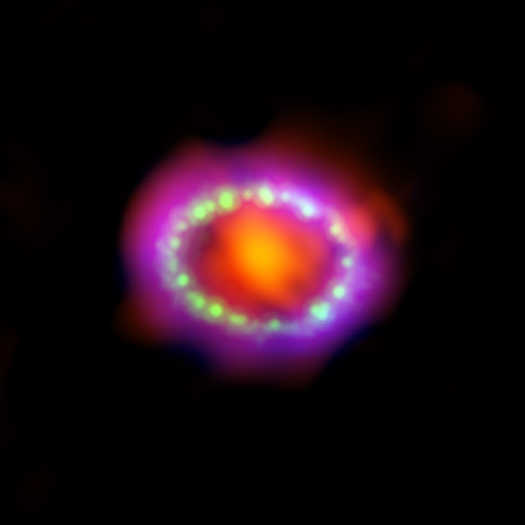
So beyond comprehension. Only thing left is awe and appreciation for these massive universal events. Let me summarize: in a galaxy far, far away a massive star 150,000 or so years ago begins shedding its outer layers 20,000 years before the main nova event; ring material from this epic shedding then sizzles from enormous shock waves from the exploding star pulverizing/ionizing its field; the final throes of this dead star will linger well beyond anything we can experientially gauge about the passage of time. And we think we have daunting challenges here on Earth. Universal reality check, I’d say.